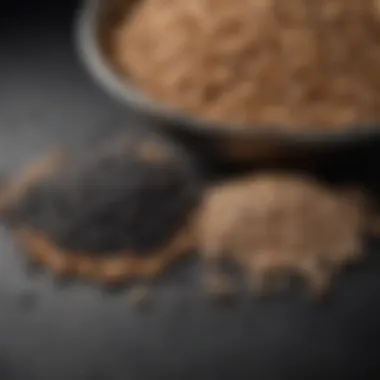Cost Analysis of Pellets vs Charcoal for Cooking


Intro
The choice between wood pellets and charcoal for cooking can significantly impact not just taste and experience, but also costs involved. As culinary practices evolve, more individuals are considering the economic implications of these fuel sources. This analysis delves into multiple facets including initial investment, purchasing prices, and long-term expenses. Culinary enthusiasts need to understand these factors to make informed decisions that balance both their budget and culinary outcomes.
Recipe Overview
Brief Description of the Dish
Cooking with wood pellets or charcoal offers distinct flavor profiles that can enhance a variety of dishes, from grilled meats to baked goods. Each fuel type brings unique properties that affect cooking times and techniques. Understanding these differences helps chefs choose the right approach for their culinary creations.
Key Ingredients
- Wood Pellets: Made from compressed sawdust, they are designed for efficient burning and can add a subtle smoky flavor.
- Charcoal: Traditional fuel made from burning wood in a low-oxygen environment. It typically provides a higher heat output and distinct flavors.
Cost Analysis
Initial Costs
When starting, the initial investment varies. Wood pellets may have a higher price point based on quality. However, they are often available in bulk, which can lower the cost per unit. Charcoal, on the other hand, is widely accessible and may appear cheaper upfront but can lead to higher ongoing costs due to the need for more frequent purchases during cooking.
Ongoing Expenses
Both wood pellets and charcoal require ongoing purchases, but the frequency and expense may differ. Pellets burn more slowly than charcoal, which means less frequent refill of the fuel source. This can lead to lower overall expense in the long run, making pellets a potentially better option for frequent cooks.
Efficiency
Efficiency is another critical factor in the cost analysis.
- Burning Efficiency of Pellets: They provide consistent heat and can burn longer, translating into less fuel consumed overall.
- Burning Efficiency of Charcoal: High temperature output is beneficial for certain cooking styles but often requires more charcoal to maintain heat.
Maintenance Costs
Taking care of your cooking setup is important. Overall, wood pellet grills need regular cleaning to prevent buildup of ash and other residues. Charcoal grills similarly require maintenance but often require less cleaning during cooking because of their high burning temperatures, which can be more self-cleaning.
The End
In summary, the analysis of costs between wood pellets and charcoal encompasses many factors, from initial investment to burning efficiency and maintenance. Culinary enthusiasts looking to understand the economic implications of their fuel choice can benefit from exploring these details thoroughly. By comprehending the long-term value of each fuel source, one is better equipped to make informed decisions that complement their culinary goals.
Foreword to Cooking Fuels
The choice of cooking fuel is an essential consideration for culinary enthusiasts. The world of cooking fuels encompasses various options, each with its own merits and drawbacks. This article will look specifically at wood pellets and charcoal, two popular fuels that have distinct characteristics. Examining these fuels is crucial, as their economic implications affect not only the budget of the home cook but also the broader environmental impact of cooking practices.
Both wood pellets and charcoal have unique qualities that make them appealing for different types of cooking. Understanding these qualities aids consumers in making informed decisions. The main focus here is to provide insights on cost analysis, efficiency, and the culinary results achieved using these fuels.
Overview of Cooking Fuels
Cooking fuels can be categorized into multiple groups. Some common examples include:


- Gas: Often used for its convenience and quick heating.
- Electricity: Widely available but less favored by traditional cooks.
- Wood: The focus of our analysis, which includes both charcoal and pellets.
Each type of fuel has its own advantages. Gas and electricity are popular due to their ease of use. However, wood-based fuels like charcoal and pellets are valued for their distinctive flavor contributions to food, as well as the ritualistic aspect of cooking over an open flame.
Historical Context of Wood Pellets and Charcoal
The history of cooking with wood dates back thousands of years. Charcoal emerged as a refined version of wood fires. Its creation involves the slow burning of wood in a low-oxygen environment, which results in a compact fuel with higher energy density. This made charcoal a favorite among cooks for its ability to burn hotter and longer than wood itself.
Wood pellets are a more recent innovation. They gained popularity in the late 20th century due to the rise in energy-efficient practices. Made from compressed sawdust, they are more environmentally friendly. The manufacturing process involves drying and compacting wood waste, thereby creating a sustainable fuel source that has gained traction in households and restaurants alike.
The evolving landscape of cooking fuels reflects changing consumer preferences and increased awareness of sustainability. As we analyze the costs associated with pellets and charcoal, understanding this historical context provides clarity on their current value.
Understanding Cost Factors
Understanding cost factors is essential when comparing wood pellets and charcoal as cooking fuels. This analysis encompasses various aspects, each contributing to the overall financial impact that culinary enthusiasts face. By recognizing initial purchase costs, ongoing expenses, and the factors that influence availability, one gains clarity on budgeting for fuel choices. Insight into these areas allows for informed decision-making that goes beyond mere fuel selection, enabling a more comprehensive evaluation of the culinary experience.
Initial Purchase Costs
The initial purchase cost is the first and most obvious factor when considering wood pellets versus charcoal. Charcoal typically comes in larger bags and can be found in most grocery and hardware stores. A typical price for a 15-pound bag of briquettes is around $10. On the other hand, wood pellets are sold in 40-pound bags, and a common price is about $6 to $8. This price difference, although relatively small on the surface, can accumulate quickly depending on how frequently one cooks.
Additionally, setup costs for using these fuels differ. Charcoal requires a grill, which can vary widely in price depending on features and brand. Wood pellet grills, such as those from Traeger or Camp Chef, tend to start at a higher price point, generally beginning around $300 and easily reaching over $1,000 for more advanced models. Therefore, potential users should carefully evaluate which initial outlay aligns best with their budget and cooking habits.
Ongoing Expenses
When it comes to ongoing expenses, the analysis must consider the frequency of use and fuel consumption. Charcoal is often priced lower but burns quicker, meaning more frequent purchases. Users may find themselves needing to buy multiple bags in a given season, increasing the practical cost over time. On the contrary, wood pellets tend to last longer due to their higher density and energy content.
Users should also consider secondary expenses such as lighter fluid for charcoal versus additional equipment for pellet grills. Designing a thorough budget for ongoing expenses can help one manage costs better in the long term. Utilization patterns will also impact the overall expenses associated with each fuel type.
Availability and Market Fluctuations
The availability of wood pellets and charcoal can greatly influence pricing and accessibility. Charcoal is widely available and can be found at nearly every grocery store or home improvement outlet. This accessibility stabilizes its market, making it a regular choice for many cooks. In contrast, wood pellets may not be as readily available in certain regions, leading to greater price variability, especially during peak demand times.
Market fluctuations also play a critical role. Prices for wood pellets can rise or fall due to factors like production rates and regional supply. A shortage in raw materials for production can have an immediate impact on pellet prices. Cooking enthusiasts need to stay informed about local market trends. The awareness of availability can assist in planning and purchasing sustainably during off-peak periods.
Conclusion: Understanding these cost factors provides a fundamental basis for assessing the financial implications of using wood pellets versus charcoal. By evaluating initial costs, ongoing expenses, and availability, one can make well-informed choices that align with culinary needs.
Cost Comparison: Pellets vs. Charcoal
The comparison of costs between wood pellets and charcoal stands as a pivotal theme in the article. This segment aims to provide a thorough understanding of the economic implications that define both choices. Factors such as the initial purchase price, ongoing expenses related to usage, and the energy value each type of fuel offers are crucial for culinary enthusiasts to consider. By evaluating these elements, readers can make informed decisions that align with their cooking needs and financial constraints. Understanding the cost comparison helps to illuminate the practicality and value each option presents in real-world applications.
Cost per Pound Analysis
In analyzing the cost per pound, one must first establish the current market prices for both wood pellets and charcoal. Generally, wood pellets are priced lower than charcoal per pound, which can lead to significant savings over time. For example, as of recent surveys, wood pellets are often available around $0.25 to $0.40 per pound, whereas charcoal might range from $0.70 to $1.50 per pound. This disparity makes pellets an attractive option for those watching their budgets.
Also, it's essential to recognize where these products are purchased. Buying in bulk can further reduce costs, making pellets even more favorable economically. It is common for cooking fuel suppliers to offer discounts for larger quantities.
Energy Content Comparison
When discussing energy content, it's vital to consider the heat output during combustion. Wood pellets typically have a higher energy density compared to charcoal. For instance, wood pellets can generate approximately 8,000 to 9,000 BTUs per pound, while charcoal often provides about 6,500 to 7,000 BTUs per pound.


This difference means that, while the upfront cost of wood pellets might be lower, they can offer greater efficiency and heat output. When calculating the total cost of cooking, including how much heat is generated per fuel dollar spent, wood pellets become a compelling alternative that can lead to savings on energy consumption.
Cost of Heating Value
The cost of heating value ties closely to the energy content discussed prior. It signifies not only the cost of the fuel itself but also how much heat each type can produce for the price paid.
The overall heating value of a fuel can gauge its efficiency in cooking. To best illustrate:
- Pellet Heating Value: If wood pellets provide 8,500 BTUs per pound at an average cost of $0.30 per pound, the heating cost amounts to around $0.035 per 1,000 BTUs.
- Charcoal Heating Value: On the other hand, if charcoal offers 6,500 BTUs per pound at a price of $1.00, this equates to about $0.154 per 1,000 BTUs.
From these calculations, it becomes evident that wood pellets not only come at a lower per-pound cost but also offer a superior heating value for cooking purposes. Thus, when assessing the overall financial implication, wood pellets emerge as a more economical fuel choice.
"Understanding the cost comparison between wood pellets and charcoal is essential for making an informed decision conducive to cooking needs."
Such insights not only aid in proper selection but also enhance cooking experiences for both casual cooks and culinary aficionados.
Efficiency in Use
Understanding the efficiency of cooking fuels is pivotal in making informed culinary choices. Efficiency directly impacts both the cooking experience and the economic implications of using wood pellets versus charcoal. A fuel's efficiency reflects how effectively it converts stored energy into usable heat, which influences cooking performance and fuel consumption. High efficiency means less waste and better performance, making it crucial for those who seek optimal cooking results.
Moreover, the efficiency of these fuels extends beyond mere heat generation. It also involves factors like the ability to maintain heat, the quality of the burn, and the convenience of use. Each of these aspects can significantly affect the culinary process and enjoyment.
Burning Efficiency of Pellets
Wood pellets exhibit a burning efficiency that many find superior to that of charcoal. The compacted nature of the pellets allows for a consistent burn rate. This means that they can sustain high heat levels for longer periods. This characteristic is essential for various cooking styles, particularly those that require stable and prolonged heat, such as smoking or slow cooking.
Another advantage is the low moisture content in wood pellets, which is generally around five to ten percent. This low moisture level results in a higher heat yield and reduced smoke production compared to charcoal. Because of these factors, wood pellets can reach optimal cooking temperatures relatively quickly, leading to quicker meal preparation times.
Burning Efficiency of Charcoal
Charcoal has been a traditional cooking fuel for generations and is favored for its unique flavor contribution to grilled food. However, when discussing burning efficiency, it generally lags behind wood pellets. Charcoal burns hotter than most other wood products, but its efficiency can be affected by how it is manufactured and the type of charcoal used.
The combustion of charcoal can result in significant ash production, which requires cleaning and can disrupt ongoing cooking. Additionally, charcoal often takes more time to reach peak temperature, which can extend the cooking process in comparison to wood pellets. Despite these drawbacks, many chefs appreciate the distinct taste charcoal can impart, which sometimes justifies its use even at a potentially lesser efficiency.
Impact on Cooking Duration
The impact of fuel efficiency can have tangible effects on cooking duration. Using wood pellets typically results in shorter cooking times due to their steady and high heat output. For example, when barbecuing, the faster heating time of wood pellets allows for reduced meal preparation time, which is particularly beneficial for gatherings or events where time efficiency is crucial.
In contrast, the inherent characteristics of charcoal can extend the duration of the cooking process. A user must account for the time it takes charcoal to ignite and reach a desirable temperature. This increased duration can be a significant factor for those who are cooking in a tight schedule.
In summary, understanding the efficiency in use of cooking fuels is essential for culinary enthusiasts. Both wood pellets and charcoal offer unique advantages and disadvantages. By evaluating burning efficiencies and their resultant impact on cooking durations, one can better decide which fuel aligns with their culinary needs.
Sustainability and Environmental Considerations
Sustainability is an essential factor when choosing a cooking fuel. In today’s world, it is increasingly important to understand the environmental impact of our energy choices. Both wood pellets and charcoal contribute to the culinary experience. However, they have different implications for sustainability and the environment.
Carbon Footprint of Pellets
Wood pellets are often viewed as a more environmentally friendly option compared to traditional charcoal. Their manufacturing process usually involves compressing sawdust, which helps utilize waste biomass from the lumber industry effectively. This efficiency reduces carbon emissions. The carbon dioxide emitted when burning pellets is generally classified as bioenergy, as the trees from which they come absorb CO2 during their growth. However, it is crucial to ensure that the pellets are sourced from sustainably managed forests. Additional transportation emissions can occur when the pellets are shipped over long distances, which can affect overall sustainability.


Carbon Footprint of Charcoal
Charcoal production is often less efficient and more pollutive than wood pellets. The process relies on the pyrolysis of wood, which produces not just charcoal but also significant greenhouse gases. Thus, the carbon footprint is higher per unit of energy generated when compared to wood pellets. Moreover, many charcoal brands source their raw materials unsustainably. Deforestation is a primary concern, as it can lead to habitat loss and increased carbon emissions in the long term. Therefore, understanding the source is crucial for assessing the sustainability of charcoal.
Long-term Sustainability Factors
When evaluating the long-term sustainability of cooking fuels, various factors must be considered. These include the growth and harvesting practices of the raw materials, the efficiency of conversion processes, and how the end-of-life options are handled. Wood pellets offer a more sustainable outlook if sourced from responsibly managed forests. The continual replanting and sustainable harvesting practices can support ecosystems.
On the other hand, charcoal’s reliance on unsustainable practices jeopardizes long-term availability. As demand grows, more forests may be under threat. Thus, culinary enthusiasts must consider the sourcing of their cooking fuel. Responsible choices, informed by understanding the full sustainability profile, can help mitigate negative environmental impacts.
"Choosing your cooking fuel wisely not only enhances flavor but also helps preserve our planet for future generations."
Practical Considerations for Culinary Application
When assessing the choice between wood pellets and charcoal for cooking, practical considerations play an essential role. Culinary enthusiasts must evaluate not only the financial aspects but also how these fuels affect the cooking experience. Understanding the practical usage of each fuel type can greatly influence both the flavor and the effort involved in preparing meals.
Flavor Profiles and Cooking Results
Flavor is often a central point for anyone considering which fuel to use for cooking. Wood pellets offer a unique advantage as they come in various wood types, each imparting distinct flavors to food. For instance, hickory pellets can contribute a strong, smoky flavor, while applewood pellets might present a milder sweetness. This versatility can allow for tailored cooking outcomes, suiting diverse culinary preferences.
In contrast, charcoal tends to deliver a more traditional smoky essence, loved by many for grilling. However, it generally lacks the variety that wood pellets provide. The cooking results can also differ in texture and moisture retention. Pellets, when used in specific pellet grills, can create a more controlled and even heat distribution, which may enhance the cooking consistency of certain dishes.
Ease of Use in Different Cooking Methods
Ease of use is another vital consideration for culinary practitioners. Wood pellets are generally straightforward to manage. They ignite easily and burn steadily, minimizing the amount of attention required during cooking. Most modern pellet grills come equipped with automatic temperature controls, making it user-friendly for both novices and experienced grillers alike.
On the other hand, charcoal requires more active involvement. It generally needs to be lit manually and often requires expertise to maintain the desired temperature throughout the cooking time. Moreover, charcoal can produce residual ash that may require careful handling and monitoring. For methods like smoking or low-and-slow cooking, the ability to adjust airflow and maintain temperature proves more challenging with charcoal.
Maintenance and Cleanup for Each Fuel Type
Maintenance and cleanup are important factors as well. When using wood pellets, the cleanup process tends to be less complicated. The ash produced is minimal and can be easily swept away after cooking. Additionally, pellet grills often have ash collection systems, simplifying the post-cooking maintenance task.
Conversely, charcoal tends to produce a significantly larger quantity of ash that can be cumbersome to clean. Users must often scrape the grill and dispose of the leftover charcoal, which may take extra time and effort. Understanding these maintenance requirements can help users prepare their cooking environment efficiently and ensure their kitchen remains clean after culinary endeavors.
Choosing the right cooking fuel involves careful consideration of flavor, ease of use, and maintenance. Whether opting for the nuanced flavor of wood pellets or the classic appeal of charcoal, each choice comes with its benefits and drawbacks.
Final Assessment
In this article, the Final Assessment section is critical for synthesizing insights gained from the comparison of wood pellets and charcoal. This part provides a comprehensive overview, allowing culinary enthusiasts to weigh economic aspects against practical implications. Evaluating the findings ensures that readers can make informed decisions based on cost, efficiency, and other pertinent factors. A good conclusion ties the various strands of discussion together and highlights the significance of understanding these cooking fuels' roles in today's culinary landscape.
Summary of Key Findings
The analysis of pellets versus charcoal has yielded several key findings that warrant attention:
- Initial Costs: Charcoal tends to have a lower upfront cost compared to wood pellets. However, prices can be volatile due to market demands.
- Ongoing Expenses: Over time, pellets may offer cost advantages due to their efficiency and lower energy consumption, especially for those who cook often.
- Environmental Considerations: Wood pellets generally produce less carbon emissions compared to charcoal. Their sourcing also tends to be more sustainable, which is an essential factor for eco-conscious consumers.
- Burning Efficiency: Wood pellets demonstrate a higher burning efficiency, resulting in longer cooking times with less fuel.
These findings highlight that while initial costs are crucial, ongoing expenses and broader environmental factors play a meaningful role in determining the overall value of each fuel type.
Recommendations for Culinary Enthusiasts
Based on the analysis complete in this article, there are a few recommendations culinary enthusiasts might consider:
- Evaluate Cooking Habits: If you cook regularly, opting for wood pellets might save costs over time. Their efficiency and longer burn times can lead to less frequent purchases.
- Consider Flavor Profiles: If flavor enhancement is your priority in cooking, keep in mind that personal preferences vary. Some cooks may find charcoal provides a unique flavor that is ideal for grilling.
- Sustainability Matters: For those concerned about environmental impact, wood pellets emerge as the more sustainable option. It may influence your decision if you wish to support eco-friendly practices.
- Trial Run: If uncertain, consider conducting a side-by-side comparison by purchasing a small amount of both fuel types. Assess which meets your cooking requirements better in terms of performance and taste.
By keeping these recommendations in mind, culinary enthusiasts can make more educated choices when upfront costs and practicality matter most.







